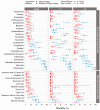Efficacy of Conventional and Biorational Insecticides against the Invasive Pest Thrips parvispinus (Thysanoptera: Thripidae) under Containment Conditions
- PMID: 38249054
- PMCID: PMC10816096
- DOI: 10.3390/insects15010048
Efficacy of Conventional and Biorational Insecticides against the Invasive Pest Thrips parvispinus (Thysanoptera: Thripidae) under Containment Conditions
Abstract
In 2020, the invasive Thrips parvispinus (Karny) was first detected in Florida, United States. In response to the implemented regulatory restrictions, we conducted laboratory experiments under containment conditions. Thrips larvae and adults were exposed to 32 products (conventional and biorational insecticides) either directly or indirectly. Direct exposure was performed using a Spray Potter Tower, while indirect exposure was conducted by evaluating residue toxicity against the thrips. Water served as a control. We assessed mortality and leaf-feeding damage 48 h post-treatment. Among the conventional insecticides, chlorfenapyr, sulfoxaflor-spinetoram, and spinosad caused high mortality across all stages in both direct and residue toxicity assays. Pyridalyl, acetamiprid, tolfenpyrad, cyclaniliprole-flonicamid, acephate, novaluron, abamectin, cyantraniliprole, imidacloprid, cyclaniliprole, spirotetramat, and carbaryl displayed moderate toxicity, affecting at least two stages in either exposure route. Additionally, chlorfenapyr, spinosad, sulfoxaflor-spinetoram, pyridalyl, acetamiprid, cyclaniliprole, cyclaniliprole-flonicamid, abamectin, and acephate inhibited larvae and adult's leaf-feeding damage in both direct and residue toxicity assays. Regarding biorational insecticides, mineral oil (3%) and sesame oil caused the highest mortality and lowest leaf-feeding damage. Greenhouse evaluations of spinosad, chlorfenapyr, sulfoxaflor-spinetoram, and pyridalyl are recommended. Also, a rotation program incorporating these products, while considering different modes of action, is advised for ornamental growers to avoid resistance and to comply with regulations.
Keywords: acute toxicity; chemical control; feeding damage; integrated pest management; mortality; residue toxicity.
Conflict of interest statement
The authors declare that there are no conflicts of interest over the ownership of the data presented in this manuscript.
Figures


References
-
- Reyes C.P. Thysanoptera (Hexapoda) of the Philippine Islands. Raffles Bull. Zool. 1994;42:107–507.
-
- Johari A., Herlinda S., Pujiastuti Y., Irsan C., Sartiami D. Morphological and Genetic Variation of Thrips parvispinus (Thysanoptera: Thripidae) in Chili Plantation (Capsicum annuum L.) in the Lowland and Highland of Jambi Province, Indonesia. Am. J. Biosci. 2014;2:17–21.
-
- Sridhar V., Chandana P.S., Rachana R. Global Status of Thrips parvispinus (Karny, 1922), an Invasive Pest. J. Res. PJTSAU. 2021;49:1–11.
-
- Thorat S., Sisodiya D., Gangwar R. Invasive Thrips, Thrips parvispinus (Karny) an Invasive Threat: A Review. Environ. Ecol. 2022;40:2170–2175.
-
- Veeranna D., Reddy R.U., Moguloju M., Padmaja G. Report on Heavy Infestation and Damage by Invasive Thrips Species, Thrips parvispinus (Karny) on Chilli in Telangana State of India. Pharma Innov. 2022;11:3845–3848.
Grants and funding
LinkOut - more resources
Full Text Sources

